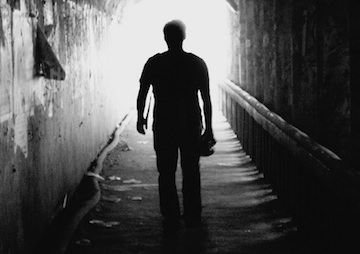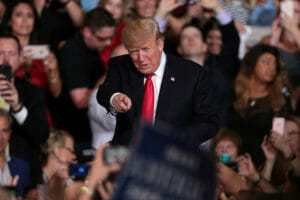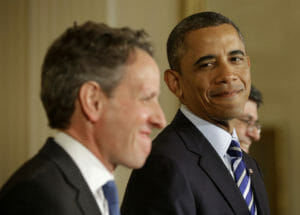The Lone-Wolf Terror Trap
The shadow of a new threat seems to be darkening the national security landscape: the lone-wolf terrorist. But most of what pundits and officials claim about it simply isn't true. Photo by kathikpasupathy (CC BY-ND 2.0)
Photo by kathikpasupathy (CC BY-ND 2.0)
By Matthew Harwood, TomDispatchThis piece first appeared at TomDispatch. Read Tom Engelhardt’s introduction here.
The shadow of a new threat seems to be darkening the national security landscape: the lone-wolf terrorist.
“The lone wolf is the new nightmare,” wrote Washington Post columnist Charles Krauthammer recently, and the conservative pundit wasn’t alone in thinking so. “I really see [lone wolves] as being a bigger threat than al-Qaeda, or the Islamic State, or the al-Qaeda franchises,” Scott Stewart, vice president of tactical analysis at the global intelligence and advisory firm Stratfor, told VICE News. Similarly, in the aftermath of the Paris terrorist attacks, appearing on “Meet the Press,” Attorney General Eric Holder said, “The thing that I think keeps me up most at night [is] this concern about the lone wolf who goes undetected.”
You could multiply such statements many times over. There’s only one problem with the rising crescendo of alarm about lone wolves: most of it simply isn’t true. There’s nothing new about the “threat” and the concept is notoriously unreliable, as well as selectively used. (These days, “lone wolf” has largely become a stand-in for “Islamic terrorist,” though the category itself is not bound to any specific ideological type.) Worst of all, its recent highlighting paves the way for the heightening of abusive and counterproductive police and national security practices, including the infiltration of minority and activist communities and elaborate sting operations that ensnare the vulnerable. In addition, the categorization of such solitary individuals as terrorists supposedly driven by ideology — left or right, secular or religious — often obscures multiple other factors that may actually cause them to engage in violence.
Like all violent crime, individual terrorism represents a genuine risk, just an exceedingly rare and minimal one. It’s not the sort of thing that the government should be able to build whole new, intrusive surveillance programs on or use as an excuse for sending in agents to infiltrate communities. National programs now being set up to combat lone-wolf terrorism have a way of wildly exaggerating its prevalence and dangers — and in the end are only likely to exacerbate the problem. For Americans to concede more of their civil liberties in return for “security” against lone wolves wouldn’t be a trade; it would be fraud.
Anatomy of the Wolf
The “literature” on both terrorism and the lone wolf should be approached with a healthy degree of skepticism. To this day, there is little consensus on what exactly terrorism is; the same is true of the lone-wolf variety.
In the media and in recent academic studies, what separates the lone-wolf terrorist from the phenomenon in general is the perpetrator. Lone wolves are, by definition, solitary individuals, almost always men, often with mental health problems, who lash out violently against civilian targets. At least in some fashion, they are spurred on by belief. Researcher Michael Becker defines it this way: “Ideologically driven violence, or attempted violence, perpetrated by an individual who plans and executes an attack in the absence of collaboration with other individuals or groups.” Although you wouldn’t know it at the moment in America, the motivation for such attacks can run the gamut from religiously inspired anti-abortion beliefs to white supremacism, from animal rights to an al-Qaeda-inspired worldview.
According to the literature, lone wolves are unique in the annals of terrorism because of the solitariness with which they plan and carry out their acts. They lack peer or group pressure and their crimes are conceived and executed without assistance. In this way, they bear a strong resemblance to the individual school shooters and rampage killers that Americans are already so used to.
One practical reason many such individuals act alone, according to researchers, is fear of detection. In “Laws for the Lone Wolf,” white supremacist Tom Metzger wrote: “The less any outsider knows, the safer and more successful you will be. Keep your mouth shut and your ears open. Never truly admit to anything.” (Before 9/11, lone-wolf terrorism in America was overwhelmingly a right-wing affair.)
This isn’t to say that individuals who commit political violence don’t talk to anyone before they attack. Recent research into 119 lone-actor terrorists in the United States and Europe, who were either convicted of such a crime or died during it, finds that they often expressed their extremist beliefs, grievances, and sometimes their violent intentions to others — mostly friends and family or online communities. The good news should be that family, friends, and colleagues might be able to help prevent those close to them from engaging in political violence if, as a society, we were to adopt strategies that built trust of law enforcement in the public, particularly affected communities, rather than fear and suspicion. (But given the record these last years, don’t hold your breath.)
On the other hand, the methods that the police and national security state seem to be exploring to deal with the issue — like trying to determine what kinds of individuals will join terrorist groups or profiling lone wolves — won’t work. The reasons individuals join terrorist groups are notoriously complex, and the same holds true for politically violent people who act alone. After reviewing those 119 lone-wolf cases, for example, the researchers concluded, “There was no uniform profile of lone-actor terrorists.” Even if a “profile” were to emerge, they added, it would be essentially worthless: “[T]he use of such a profile would be unwarranted because many more people who do not engage in lone-actor terrorism would share these characteristics, while others might not but would still engage in lone-actor terrorism.”
As a group, such solitary terrorists differ from society at large in one crucial way: almost one out of three had been diagnosed with a mental illness or personality disorder before engaging in political violence. Another study concentrating on 98 U.S. perpetrators found that approximately 40% had recognizable mental health problems. The comparable figure for the general population: 1.5%.
Given such high rates of psychological disturbance, there’s a chance individual attacks could be prevented if at-risk people got the mental health care they needed before they took a violent turn.
Fact vs. Fiction
Fortunately, what makes lone wolves so difficult to detect beforehand renders them more impotent when they strike.
Because such individuals don’t have a larger network of financing and training, and may be disturbed as well, they are likely to have a far less sophisticated skill set when it comes to arming themselves or planning attacks. Terrorism researcher Ramon Spaaij of Australia’s Victoria University created a database of 88 identified lone wolves who perpetrated attacks between 1968 and 2010 in 15 countries. What he found should dispel some of the fear now being associated with lone-wolf terrorism and so the increasingly elaborate and overzealous government planning around it.
a>Spaaij identified 198 total attacks by those 88 solo actors — just 1.8% of the 11,235 recorded terrorist incidents worldwide. Since lone wolves generally don’t have the know-how to construct bombs (as the Unabomber did), they usually rely on firearms and attack soft, populated targets, which law enforcement responds to quickly. Therefore, Spaaij found that the average lethality rate was .062 deaths per attack while group-based terrorists averaged 1.6 people per attack.
Inside the United States, 136 people died due to individual terrorist attacks between 1940 and 2012 — each death undoubtedly a tragedy, but still a microscopic total compared to the 14,000 murders the FBI has reported in each of the last five years. In other words, you shouldn’t be losing sleep over lone-wolf attacks. As an American, the chance that you’ll die in any kind of terrorist violence is infinitesimal to begin with. In fact, you’re four more times likely to die from being struck by lightning. If anything, the present elevation of the lone-wolf terrorist to existential threat status in Washington creates the kind of fear and government overreach that the perpetrators of such attacks want to provoke.
If individual terrorists are the “new nightmare,” it’s only because we allow them to be.
Lone Wolf ≠ Muslim
During the December hostage crisis at a café in Sydney, Australia, orchestrated by Man Haron Monis, an Iranian immigrant, former CIA Deputy Director Michael Morell had this dire prediction: “[W]e’re going to see this kind of attack here,” he told “CBS This Morning.” “It shouldn’t surprise people when this happens here sometime over the next year or so, guaranteed.”
This was typical of the recent rhetorical escalation by officials and former officials in the national security state when it comes to this kind of terror. But Morell’s prediction was no prediction at all. Such attacks do occur here. One had, for instance, been solved a little more than a month earlier. Eric Matthew Frein was apprehended the day before Halloween through an intensive search in the Pocono mountains of Pennsylvania after shooting two state troopers outside a police barracks with a sniper rifle in September. Officer Corporal Bryon K. Dickson II died, while Trooper Alex T. Douglass was wounded. Frein, whom authorities initially called an “anti-government survivalist,” was eventually charged with two terrorism counts after he told police that the shootings were a way to “wake people up.” They also found a letter he had written to his parents stating that he wanted to “ignite a fire” because only “another revolution can get us back the liberties we once had.”
Individual violence like this, whether labeled as terrorism or not, is nothing new. It’s been dealt with for decades without the kind of panic, fear-mongering, and measures being instituted today. After all, according to Spaaij, between 1968 and 2010, 45% of all individual terrorist attacks recorded in 15 countries occurred in the United States.
However, as Spaaij and his research partner Mark Hamm discovered, these figures are distinctly bloated. The reason is simple: included in them are numerous examples of “individual” terrorist acts inspired by al-Qaeda-style ideology that actually resulted from law enforcement-instigated or -aided plots. Spaaij and Hamm found that at least 15 of these had occurred between 2001 and 2013. In them, a “lone” perpetrator would actually be involved with, and often directed or encouraged by, a government informant or undercover agent. This adds up to about 25% of post-9/11 cases of lone wolfism in the U.S., though the label is hardly accurate under the circumstances. These are essentially government stings, which not only inflate the number of individual terrorism incidents in the U.S., but disproportionately focus law enforcement attention on American Muslim communities.
An egregious example was the case of Rezwan Ferdaus, a 26-year-old Massachusetts man and American Muslim. The FBI busted him in 2011 for conspiring with undercover agents to build crude explosive-laden drones out of remote-controlled planes to fly into the Pentagon and the Capitol Building. In reality, this was a government-concocted plot, and Ferdaus was no lone wolf. (He was incapable of thinking this up or carrying it off on his own.) The FBI ignored clear signs that their target wasn’t a terrorist, but a mentally ill man, deteriorating rapidly. Nevertheless, he was repeatedly termed a lone wolf by law enforcement and the media. Charged with providing material support to terrorists, in 2012, he was sentenced to 17 years in prison.
By contrast, when the apparent lone wolf isn’t a Muslim or other minority, he rarely finds the fear-inducing terrorist label pinned on him by the government, the media, or security experts. Take James von Brunn, a white supremacist who murdered a security guard at the United States Holocaust Memorial Museum. According to the Department of Homeland Security, the act had no connection to terrorism, although it was ideologically motivated, as one FBI official acknowledged.
Or Francis Grady, who tried to burn down a Planned Parenthood clinic in Grand Chute, Wisconsin, in 2012, because, as he told a U.S. district court judge, “They’re killing babies there.” Grady was not charged with a terrorism offence either. When asked why, Assistant United States Attorney William Roach said that Grady had tried to burn down an unoccupied room in an empty building.
Compare those reactions to the case of Zale Thompson, a disturbed African-American man who attacked four New York City police officers in October with a hatchet. Only a day after the attack, Police Commissioner Bill Bratton said, “I’m very comfortable this was a terrorist attack, certainly.” The apparent evidence: Thompson was a recent convert to Islam who had visited websites affiliated with terrorist groups like al-Qaeda and ISIS.
As Glenn Greenwald has pointed out, “Terrorism is simultaneously the single most meaningless and manipulated word in the American political lexicon.” The same can be said of its lone-wolf version. Not surprisingly, it has by now become essentially synonymous with being Muslim and little else, which stigmatizes American Muslims and makes their communities targets for abusive law enforcement techniques, including FBI-style sting operations and massive, intrusive surveillance. Typically, one terrorism researcher defined lone wolves as “individuals pursuing Islamist terrorist goals alone.” In reality, Muslims have no more of a monopoly on lone-wolf terrorism than they do on terrorism more generally.
Counterproductive Responses
At the moment, the response to the lone-wolf hullabaloo, like so much else in recent years, is inching us further down the path toward an American police state. One government response, now being re-emphasized, comes (of course!) with its own acronym: countering violent extremism, or CVE.
The program, announced in 2011, aims to partner with communities — almost exclusively Muslim ones in practice — in the name of terrorism prevention. One of the ways communities are to do this is by creating safe spaces where individuals can discuss politics and religion without fear of lurking government agents. Yet members of these same communities will then be encouraged to report back to authorities about what was said and by whom in an effort to identify those at-risk of becoming violent extremists, whether alone or in concert with others. American Muslim communities have already experienced government stings and infiltration by informants, and tasking community members to report back to authorities doesn’t seem much different than directly putting agents in their midst.
If CVE’s goal is to build the capacity within communities to prevent violence and terrorism, lone or otherwise, then agencies like Health and Human Services and the Department of Education should be leading the way. They could provide social and mental health services and educational resources — to all communities instead of singling particular ones out based on religion, race, or ethnicity. Instead, not surprisingly, the White House has put the Department of Homeland Security, the Department of Justice, and the FBI in charge of executing its CVE programs, while emphasizing the coordinating role of local U.S. Attorneys’ Offices. American Muslim communities are rightly leery of this arrangement, particularly in light of the way these outfits have recently focused on religious beliefs as a basis for suspicion and, at least in the FBI’s case, have manufactured terror plots by preying on the sick and the vulnerable.
Other proposed solutions to the “lone-wolf” problem are even more indiscriminate.
In a recent book, former RAND Corporation analyst Jeffrey Simon offers an inventory of possible technological strategies for identifying the wolf in sheep’s clothing before he attacks. These are typical of our moment and include the widespread use of Internet-enabled smart surveillance cameras, as well as the active, suspicionless monitoring of Internet and social media usage. Another increasingly popular approach he suggests is the expansion of biometric collection, meaning the government would assemble biological traits unique to each individual, such as facial dimensions and DNA, without any evidence of wrongdoing.
It should be noted that such an approach — and it’s typical of the direction the national security state and law enforcement have taken in these years — would represent a fundamental assault on a free society. Such “countermeasures” should send a shiver down your spine. Simon seems to recognize this, writing, “Privacy issues will have to be addressed, including the willingness of the public to have their facial expressions, eye movements, heart rates, breathing patterns, and other characteristics captured by sophisticated sensors wherever they go in order for a decision to be made by others concerning what they might be intending to do.”
The dangers to Americans in allowing government agencies to collect such intimate information in order to discover whether any of them are possible lone wolves should be obvious in terms of the destruction of privacy, among other things. The result would be both an Orwellian world and a hopeless one in safety terms. It’s already clear that none of these expensive and advanced technological “solutions” will work. Totally innocent conduct (“false positives”) will overwhelm the truly menacing. Some of these approaches, like surveillance cameras, may help finger a perpetrator after the crime, while others, such as trying to identify who will engage in terrorism by his body language, will only further contribute to the security theater the government has staged since 9/11.
Nevertheless, the ineffectiveness of an intrusive security state won’t stop its adherents from pushing for more power and methods of control that are ever more intrusive. “We have to put… aside… all the bleeding-heart, politically correct people who say we can’t be emphasizing one community over the other,” VICE quoted Congressman Peter King as saying in a radio appearance. The threat, he added, is “coming from the Muslim community and it shows that the [New York Police Department] and [former police commissioner] Ray Kelly were right for so many years when they were really saturating areas where they thought the threat was coming from.”
The once-secret NYPD suspicionless surveillance program King is referring to — it stretched from Connecticut to Pennsylvania — never produced a single terrorism lead, much less a conviction. It was “successful” at only one thing: making American Muslim communities in the greater metropolitan area feel as if they were under siege and destroying trusting relations between them and the police.
As King demonstrates, the people who pledge to protect our lives and our liberties are often the same ones who cry wolf. With shepherds like these guarding the flock, wolves may be beside the point.
Matthew Harwood is senior writer/editor of the ACLU and holds an M.Litt. in International Security Studies from the University of St. Andrews in Scotland. His work has appeared at Al Jazeera America, the American Conservative, the Guardian, Guernica, Salon, War is Boring, and the Washington Monthly. He is also a TomDispatch regular.
Copyright 2015 Matthew Harwood
Your support matters…Independent journalism is under threat and overshadowed by heavily funded mainstream media.
You can help level the playing field. Become a member.
Your tax-deductible contribution keeps us digging beneath the headlines to give you thought-provoking, investigative reporting and analysis that unearths what's really happening- without compromise.
Give today to support our courageous, independent journalists.






You need to be a supporter to comment.
There are currently no responses to this article.
Be the first to respond.